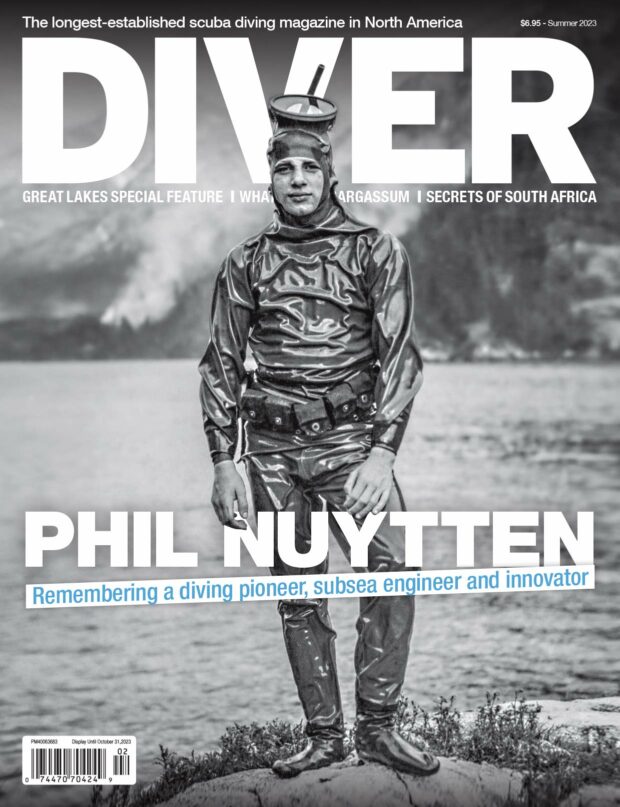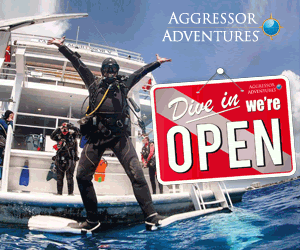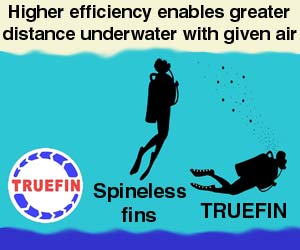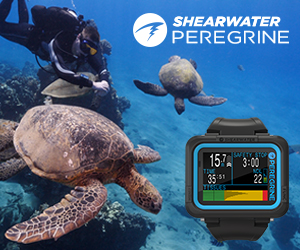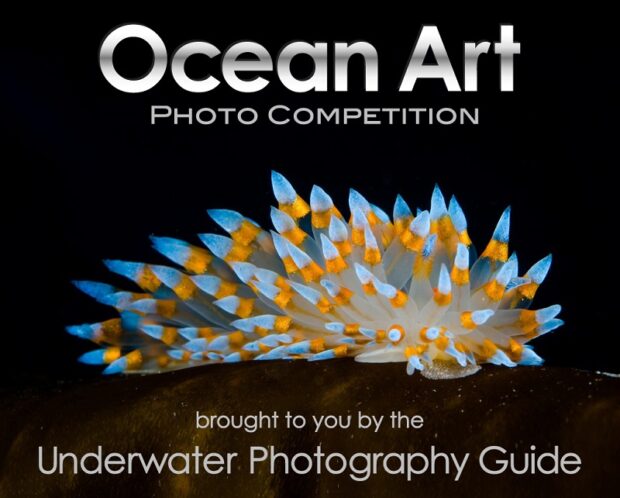Becky Kagan Schott: Shooting Star
At 30, Becky Kagan Schott’s already an Emmy winner but the over achieving cinematographer believes the best is yet to come
Interview By Michael Menduno – First published Volume 38 Issue 2
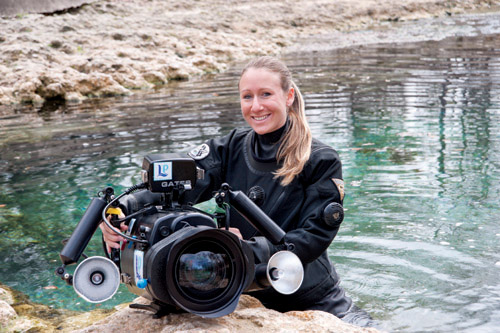
Talent plus personality. That’s how clients and colleagues explain 30-year old Becky Kagan Schott’s rapid ascent in the male-dominated, niche-filled world of underwater cinematography. “There are only a handful of people you can call if you need someone to dive to 350 feet (110m), shoot and be creative,” explains Evan Kovacs, director of underwater photography at Woods Hole Oceanographic Institute’s Advanced Imaging and Visualization Lab. “There’s probably only two women in the world that could pull it off and Bec is one.” He calls her a breath of fresh air. “Even when she’s not in charge, she’s able to bring ideas to the table in a non-threatening way.” No small thing in a field fraught with IMAX-sized personalities.
Colleague, British underwater cameraman Rich Stevenson, says that her skilled and energetic ‘let’s do this’ attitude is the icing on the cake. The ex-Royal Marine conducted a series of two to three hour dives with Schott to shoot shipwrecks more than 300 feet ((90m) deep in 34°F (1°C) water for a 3D film project in the Great Lakes. It was Schott’s first coldwater assignment. “No matter how challenging our dives, she just cracked on without a complaint,” he says. Schott’s mask actually frosted up during deco.
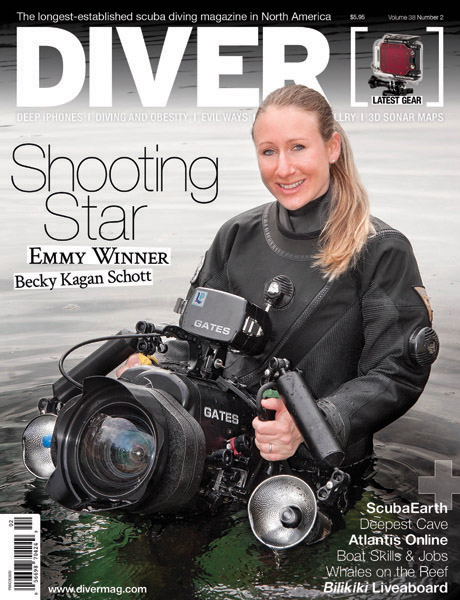 Those are some of the reasons that the former Fox News cameraman has become a go-to-gal for clients like Woods Hole, Discovery Channel, National Geographic, the Military Channel, Current TV, the National Park Service’s Submerged Cultural Resource Unit and others. And it’s why the phones are ringing off the hook at her company Liquid Productions LLC, which she started six years ago with husband and fellow cameraman David Schott. The deep diving duo spent nearly 180 days on location over the last 12 months diving and shooting in “challenging” aquatic environments. Their specialties: caves, deep shipwrecks, cold water, under ice, and swimming with big animals.
Those are some of the reasons that the former Fox News cameraman has become a go-to-gal for clients like Woods Hole, Discovery Channel, National Geographic, the Military Channel, Current TV, the National Park Service’s Submerged Cultural Resource Unit and others. And it’s why the phones are ringing off the hook at her company Liquid Productions LLC, which she started six years ago with husband and fellow cameraman David Schott. The deep diving duo spent nearly 180 days on location over the last 12 months diving and shooting in “challenging” aquatic environments. Their specialties: caves, deep shipwrecks, cold water, under ice, and swimming with big animals.
Schott’s seeming overnight success is the result of nearly two decades of singular focus on her twin passions of diving and telling stories with pictures. Her diving CV is a testament to her youthful enthusiasm and dedication – call it a predilection – to her craft. Open water certified at age 12, Schott then wasted little time becoming cavern certified at 14 after her family moved to Florida. Next she qualified as a Master Scuba diver, and completed her ‘Intro to Cave’ course at Ginnie Springs two years later while working in a local dive shop. She was hooked. Schott logged more than 200 cave dives including stage and scooter dives by the time she was 18 and old enough to earn her Full Cave certification through the National Speleological Society – Cave Diving Section (NSS-CDS). She completed a NAUI instructor course the same year and TDI Trimix training the year after, at 19. She started diving rebreathers six years later.
Her image making followed a similar tack. Having brought a camera to her first scuba class, Schott went on to study photography and TV production in high school, and then earned a B.A. in journalism from the University of Tampa in 2004. She landed her first job out of college as a news cameraman with CBS and later Fox News, while teaching scuba on the side.
In 2006, Schott met her soon-to-be husband, David, online; the two had lots to chat about. He was an underwater videographer and avid technical diver with a rebreather and an MBA from Widener University. They decided to test their budding relationship with a dive at Eagle’s Nest cave system in North Florida. That cemented the deal. Within the year the two took the plunge. They moved in together and formed Liquid Productions in 2007, the year Becky got her first break as an underwater cameraman. The couple married two years later.
Some couples have a song. The Schotts have a cave. In 2011, they received their first Emmy and an Edward R. Murrow award for their documentary of Eagles Nest Cave for CBS. A year later, National Geographic hired Liquid Productions to shoot their 2012 end-of-the-world special Mayan Underworld: The Real Doomsday, and named Becky underwater director of photography, a job she’d dreamed of holding for almost 16 years.
So where do you go when you’ve realized your life ambition and you’re still only 30? Here’s what the diminutive, five-foot-five, tekkie image-maker had to say.
Menduno: Do you consider yourself a cinematographer, a photographer, a journalist? How do you view your work?
Becky Kagan Schott: I look at myself as a photojournalist. I really want to tell a story through images, whether it’s video or still photography. I think that it’s really important that it’s not just an image. It has to mean something, or inspire someone, to tell some kind of story. I love to show people interacting with the underwater environment.
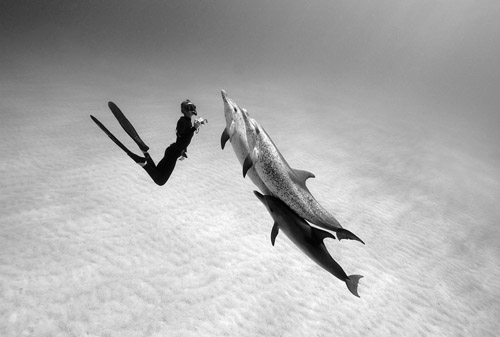
That makes me think of the image you shot of a woman free diver suspended vertically in the water column facing three dolphins. Do you know the one I am talking about?
Becky: Absolutely. That image won the National Geographic Traveler photo contest in 2011. It was taken in the Bahamas. What’s amazing about that image is that it looks like it’s frozen in time, as if it happened in slow motion. But in reality it occurred literally in a split second when the diver turned and the dolphins turned upwards to face her and then they were gone. I probably took, who knows, 400 pictures of that pod over the couple of hours that they stayed with us. A bunch turned out good, but that one single image was really special.
What makes that one so compelling?
Becky: People look at pictures of dolphins and might go, wow. But in this case, when you can show a diver interacting with the dolphins, it’s much more emotional. People look at it and go, that could be me, and I think that’s why it’s so powerful and draws the viewer in. I don’t know if that sets me apart from others, but capturing that interaction, whether it’s between humans and animals or places, like caves or shipwrecks, is something that I feel in my work.
Well, it’s obvious that others are feeling it too! In addition to winning the Traveler photo contest, in the last year and a half you and David won an Emmy and an Edward R. Murrow award for your documentary on Eagles Nest cave system, you were inducted into the Explorers’ Club, you’re about to be inducted into the Woman Diver’s Hall of Fame, and you were the underwater director of photography for Nat Geo’s Mayan Underworld: The Real Doomsday, which just aired in December. All that and you just turned 30 years old!
I feel so young to have received these honours. It really means a lot. And being the underwater DP for a Nat Geo special! Wow. That was really a high point. I was walking around out there feeling like Wes Skiles [Becky smiles]. He was one of my role models. [Skiles was one of National Geographic’s go-to photographic directors for caves before his passing in 2010].
To me, it was the ultimate dream job and what I have been working towards all these years. To have the opportunity to really be creative with lighting and shot composition and directing underwater scenes for Nat Geo felt like a huge accomplishment. It was pretty amazing.
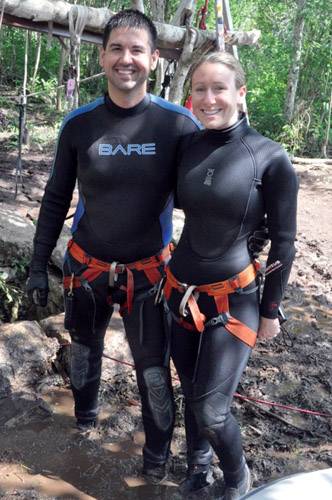
It’s a dream that you have been pursuing for a long time.
Becky: When I was very young, 10 or 11, I wanted to be an ichthyologist. My friends were like, huh? I memorized the names of fish in saltwater aquariums at the local pet shop. I loved sharks and was fascinated watching documentaries and seeing them on television. Now when I look back, I realize that’s what sparked my passion to be an underwater cinematographer.
And that’s what got you started in diving?
Becky: My parents gave me a subscription to Skin Diver magazine when I was 10, which really opened my eyes to the world of scuba. Then two weeks before my 12th birthday, I was on a trip to Florida with my dad and the hotel we were staying at had a dive shop that offered resort courses. My dad paid for the course, and I knew from that first second underwater, that that’s what I wanted to do for the rest of my life. I was hooked. When we got home, I found a local dive shop, and begged my parents to drive me to scuba lessons. I did a lot of babysitting to pay off those lessons. [Becky chuckles]
You got certified when you were only 12 years old!
Becky: When I tell people I have been diving for 18 years, they look at me funny, like “are you lying to me?” Nope, I started when I was 12. I still keep in touch with my scuba instructor, Sue Smiley. She told me later that they didn’t accept students until age 14, but I was so excited about diving that she couldn’t turn me away. Thankfully she didn’t. She certified me and started my whole career.
Your dad passed away that next year and you and your mom moved to Orlando, Florida. Was it harder for you to go diving because of the association?
Becky: My life would have been very different if my dad hadn’t encouraged me to learn to dive the year before. Diving helped me through his passing. It gave me goals, something to focus on. I was doing something no one my age was doing and it kept me out of trouble. I was working to earn my next regulator instead of hanging out with the bad kids and smoking in the back of the schoolyard.
Tell me about your photography. Was that also informed by your diving experience?
Becky: I started taking pictures when I was very young. I always had a disposable, even from my very first scuba class, but I probably got more serious about it when I was 14 because my family didn’t dive. So I wanted to be able to show them what I was seeing underwater and why I loved it so much, especially my mom.
You studied photography in high school, got involved in the school’s TV production program in your freshman year and went on to become the anchor for the school’s daily news show.
Becky: The news show really gave me my first taste for television, editing and putting stories together. It also showed me that you could touch a lot of people by what you do. I would go shoot something, put together a little video and then broadcast out to four thousand students. People would come up and tell me that they really enjoyed it. It showed me how powerful media can be.
So you stayed with it.
Becky: I went on to get my BA in journalism at the University of Tampa, where I did everything from documentaries to news reporting and ended up getting an internship at the local NBC station, which was right across from the school. That gave me my first start.
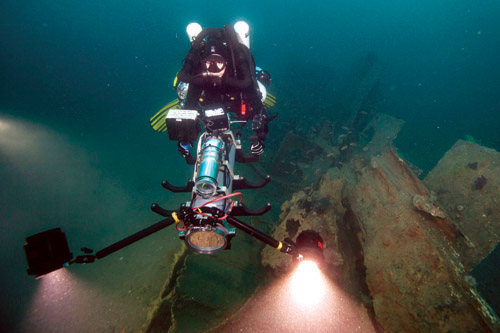
Most people probably don’t realize that you started your career in the news business.
Becky: I was lucky to get a job as a photojournalist right out of college and it allowed me to really hone my topside skills. I don’t think you can just go be an underwater videographer. You have to know a bit about cameras and how to shoot and what makes for a good shot and sequence and things like that.
I worked in TV news from 2004 until 2009. First at CBS in Ft. Myers and then at Fox in Tampa, and later in Philadelphia. I stayed in news, even after my husband Dave and I started our own production company, Liquid Productions in 2007.
What was it like?
Becky: News was like an 80-hour a week job. I wouldn’t want to be doing it now but it was great experience. In Florida I did everything from covering alligators in backyard pools to shooting so many hurricanes and brush fires. I even reported on a few horrible crime stories when we moved back to Philadelphia and got to cover campaign rallies in the 2008 presidential election. But by 2009, Dave and I had enough work for me to leave and focus on our own company.
You and David specialize in shooting in extreme underwater environments like caves, shipwrecks, or under ice. I imagine that’s a difficult niche to fill.
Becky: It’s not just being able to do the dives but being able to shoot and handle yourself in those environments. There’s a lot more that goes into that kind of shoot, a lot more planning, a lot more hazards, and it takes, I’m not tooting my own horn here, but I think it takes a certain personality to deal with the problems that come up. It’s not just a dive trip.
Believe me, these things do not go smoothly. You’re often in foreign countries. Equipment doesn’t show up. You need batteries. Sometimes people don’t always want you there depending on the shoot and the weather doesn’t always cooperate. But you do whatever it takes to get it done and make the shoot successful. That’s how you make a reputation for yourself and hopefully get called for more jobs in the future.
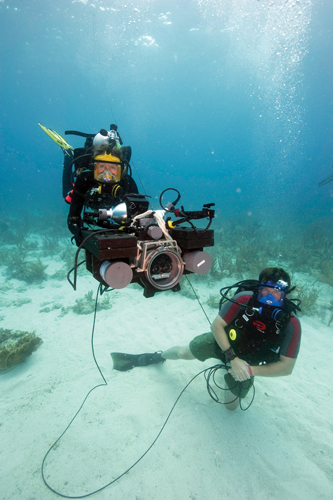
It sounds like hard work.
Becky: We often work 20-hour days, for days in a row. There’s no weekend, there’s no hey, I’m tired, I’m sleeping in today. It’s just not how this job goes. Like the Nat Geo job [Mayan Underworld] that we just finished working on in Mexico. It was two shoots, 10 days each and it wasn’t always pretty. I probably only got three hours of sleep a night by the time we were done reviewing the day’s footage, production meetings and prepping the equipment. It was not a vacation.
Tell me about it.
Becky: We were diving in some very remote locations in the Yucatán. Not Rivera Maya but the Yucatán. A lot of the locations required 80 to 85 foot (24-26m) rappels to get down into the cenote and there was no land for staging. So we needed to float everything down there. We had zodiacs in the water to clip off our gear and then we’d dive to 150 feet (46m) in this giant cave and shoot Mayan remains, skulls and artifacts.
The problem was that the weather was getting worse because of an approaching hurricane and the cenote started acting like a giant drain. There was just mud pouring down on top of us, and swirling around in the water. It was like being in a giant toilet.
What did you do?
Becky: It was very stressful because the producer was pushing to get the shots. He wanted to get them done. I had a team of 10 people in the water doing lighting, communications, cables and talent and second cameras. I was trying to hold it together but things were getting hairier with the mud waterfall, visibility and delicate artifacts that were thousands of years old that we didn’t want to damage. It just wasn’t safe for us, or for the artifacts, and I had to make the call.
That must have been difficult, particularly on your first Nat Geo job as underwater DP!
Becky: It was a tough call to make, especially when you’re getting paid to be on the job and you’ve got a producer saying, we’ve spent hundreds of thousands of dollars for these shots, the host is here, the crew is here and we want to get it done. I hated to be the bearer of bad news, but I had to tell them, ”It’s not going to happen.”
What did happen?
Becky: We ended up having to go back and film in a different location about a month later, and that went pretty well. But it was still high stress between managing the rebreathers, multiple cameras, lights, and coordinating the team to make sure everyone was on the same page. Fortunately, we had great weather, got all the shots we needed and then some and everyone went home feeling great about the show.
Have you found it difficult to break into what has been a very male-dominated field?
Becky: It’s a tough field to break into whether you’re a male or female. But yes, I am a girl. Thanks for noticing [Becky laughs]. I do this because I love it and can’t imagine doing anything else. I don’t think about being a woman when I’m doing it. When I was younger I worried about people taking me seriously. But now, I do all the tech dives, I carry the big cameras, I dive in challenging places and I come home with the images, so I just let my work speak for itself.
How did you get your first break as an underwater cameraman?
Becky: It was in 2007. Dan Crowell hired me for a TV series called, Quest for Sunken Warships for the Military Channel. They wanted a female talent/underwater videographer. A friend of mine told them, “I know this girl.” I was 25 at the time and had the look they wanted. They took me on and Dan trained me to dive a rebreather for the show, which was really cool. He was also the underwater DP for Deep Sea Detectives and I learned quite a bit from him.
Quest was my first TV series. Later Discovery picked up the show and it’s still airing today. When I look back now, I realize that I was so new at the time. I have learned so much in the last five years.
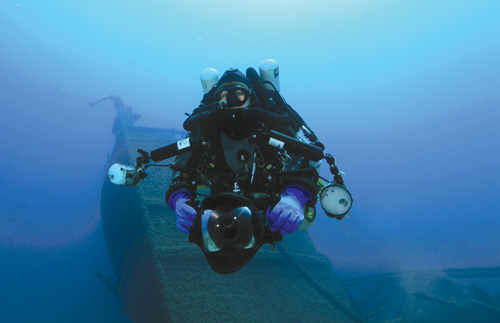
That was your introduction to rebreathers as well?
Becky: Yeah. At the time, I knew their benefits for filming, but I was also doing a lot of 300-foot (91m) open circuit dives and starting to feel that I was hitting the limit of what I could do. So I was interested in rebreathers to extend my range.
And now they are a mainstay for you. I see you dive a Meg. [Megalodon made by Inner Space Systems Inc.]
Becky: I love my Meg but I am also certified on the [AP Diving] Inspiration and the KISS. They’re fantastic tools that allow me to do so much more than I could ever do with open circuit scuba. I’m able to stay down a lot longer, whether it’s in 60 or 90 feet (18-27m) of water, or spending an hour at 300 feet (91m). I get closer to most marine life and even get clear audio versus hearing the sound of a diver’s breathing on the video. There are many benefits.
What happened after Quest?
Becky: Dave and I started getting work from Woods Hole Oceanographic Institution (WHOI), which has become a steady client. I have done a lot of projects with them over the last five years including documentaries and expeditions and working with 3D-video for TV. I shot topside for the 2010 Titanic Expedition for British TV, and worked on an amazing documentary called Project Ship Hunt last year up in the Great Lakes. Sony funded the project and it aired on Current TV.
It was an educational program?
Becky: That’s right. We took five students ages 16 and 17 and taught them how to hunt for a shipwreck. Some of them had never been on a boat before and they had no idea what was in their own backyard in Michigan. They thought everything had already been found. We really opened their eyes and hopefully viewers’ eyes as well. Every photographer dreams of inspiring someone, but when you can introduce a younger generation to our world and show them there’s still so much to be discovered it’s really a thrill. It’s been a passion of mine ever since.
You’ve worked on a diverse array of projects from cave diving and shipwrecks to filming wildlife, to being underwater cameramen for Discovery’s new TV series Bering Sea Gold.
Becky: Every time we get called for a job its something slightly different and unexpected and I love that. Whether it’s something that no one has seen before like a virgin wreck, or something I’ve never shot before like humpback whales, which I got to do this year, or shooting great whites outside a cage near Guadalupe Island. Sometimes it’s a personal challenge, or photographic challenge or challenges with depths and currents. I’m always trying to better myself, and my dive education and so I am interested in all of it.
Any favourites?
Becky: One of my all-time favourites was a 3D shoot we did up in Isle Royale National Park for the National Park Service’s Submerged Culture Resources Center. I had never heard of Isle Royale before. I had to Google it. It’s a tiny island in Lake Superior and the water is 34-36°F (1°C-2°C). At the time, I hadn’t done much cold water diving and I was a bit nervous, but I was like, all right, I’m ready for a challenge.
Break out the dry gloves!
Becky: We were up there for three weeks that first time, and it quickly became one of the favourite places I’ve ever been. It’s a graveyard for shipwrecks, many of which are intact and absolutely incredible to dive on. There are wrecks from the 1800s to the mid 1990s and the wood and artifacts are very well preserved in the cold fresh water as if they had sunk yesterday. It’s amazing. There are purses and boots and belts and porcelain hand mirrors strewn in and around the wreck. In the ocean, most artifacts are usually covered in mud, or coral or just gone. It was just fascinating to see.
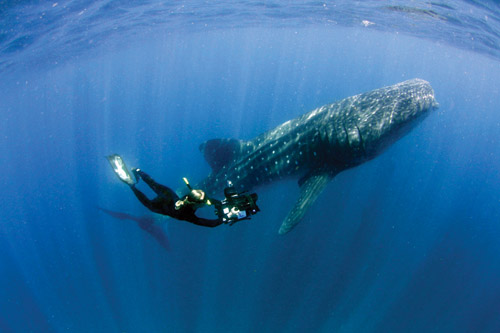
You mentioned that Wes Skiles was one of your role models.
Becky: I’ve often thought that I wanted to be the female Wes Skiles. I’ve been enamoured with his work since I was 14. Later when I got into cave diving and began to understand more about photography, I could really appreciate how amazing he was. Wes wasn’t just a cameraman. He was also an amazing still photographer and director. He did stuff 20 years ago that would be difficult to replicate today.
What kind of relationship did you have?
Becky: It’s funny; I’d been emailing Wes since I was 18. You know, “Hi Wes, will you look at my photos? If you ever need an intern or whatever, please call me.” He ignored me for years, which was fine. I get a lot of those emails now and I understand. So I just kept working towards my goals and getting more shows and building a name for myself. A couple of years ago he took notice and called. He said, “I’m working on this project and I’d like to get you involved.” Of course, just having him ask meant the world to me.
Did you get to work with him?
Becky: Sadly no. I never did. He passed away six months later. It’s one of my bigger regrets. I really wish I could have.
Wes died while diving a rebreather on Nat Geo shoot in Florida. He was alone at the time. Has it changed the way that you dive your rebreather?
Becky: That year, I lost 5 friends and acquaintances over a 12-month period; four were diving rebreathers, one was on open circuit. And I’ve lost other friends diving rebreathers prior to that and since. It’s really taught me never to be complacent, and to always, number one, watch the rebreather over everything else. I love my rebreather. I trust it. But at the same time, I don’t trust it and I’m always watching it, if that makes sense.
You have a lot to watch with the rebreather and cameras and your crew!
Becky: That’s why I love to have a safety diver with me. Someone who is competent and there to watch and help out if there is a problem. Because you know what? It’s easy to make mistakes. So I just think it’s smart to have somebody there watching my back. So many of the fatalities in the past few years have involved solo diving, whether they’ve been on rebreathers or open circuit. I believe that those people would have had a better chance of surviving if they had someone with them, and even if they still passed away, we might know more about what happened.
Have you ever had an incident?
Becky: I’ve never had to bail out on my Meg but I had a close call. I was shooting in about ten feet (3m) of water pushing a very big camera around and fighting the surge. I was on and off the boat a lot and a safety diver was snorkelling above keeping an eye on me. I couldn’t see my heads up display very well because there was so much ambient light but I was adding a lot of oxygen manually. Suddenly I felt light headed, which never happened before. I felt like I was going to black out. I immediately knew something was wrong. I looked at my handset and my PO2 read 0.16. [Hypoxic levels]. And I was like, Oh My God! I immediately flushed the loop and headed towards the surface in case I was going to pass out.
I found out later that my solenoid wasn’t in all the way. It probably got knocked loose getting on and off the boat, and it wasn’t adding oxygen to the loop. Scared the living daylights out of me. All I could keep thinking for the next year was it’s as easy as that. One tiny mistake and that could be it. Since then I have been even more diligent about watching, slowing down and doing things right no matter how hard we’re pushing on production.
Checklists?
Becky: I do my checklist on every dive no matter what. I have it written in my wet notes. It gives me a little peace of mind. And I actually do everything on the checklist, not just look at it and go, yeah, I think I did that. If I can’t remember if I analyzed my tanks, I go back and I re-analyze them, because that’s how you catch problems. I also make checklists for my cameras so I can make sure that everything is plugged in and good to go before I hop in the water. It’s often the little things like remembering to put fresh batteries in the monitors or formatting the cards that can trip you up.
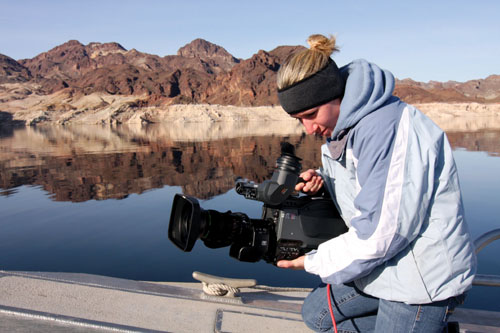
You’ve accomplished so much at a young age. Do you and David have a goal or vision of where you’d like to go from here?
Becky: I absolutely love what I do and I’m very lucky to have hit my original goals so soon. So being an overachiever I’ve had to re-evaluate, what I want to do in the next 10 years, what our goals will be for the future?
For one thing, I’d like to do more television series versus doing single documentaries, like the Bering Sea Gold stuff we shot for Discovery. You show up and you’re in one place for a month and shoot several episodes versus just do a week or 10-day shoot. But I also see us growing as a company. I’d like to see us pitching our own documentaries to the networks and producing shows in the future. That’s the next logical step.
You mentioned to me that you have some of your own projects that you and Dave have been working on in between jobs. Would you share one that’s in the works?
Becky: One of the projects we’ve been working on is an hour-long documentary about the Weeki Wachee Springs Cave. The post-production is almost complete. It’s one of the deepest cave systems in the U.S. at over 400 feet (122m) deep and an extremely challenging cave to document because of the violent entry. There’s a small shift that has over 100 cubic feet of water per second flowing out if it. It’s dangerous. You can only enter the cave when there’s a severe drought and the water pressure is very low, and that only happens a couple of months every decade. It took a team of 10 of us to get all of our cameras, lights, DPVs [diver propulsion vehicles], and safety bottles into the system for a single video dive. In fact, it’s the only video that has ever been shot in the cave.
We’ll be watching for it. What advice would you offer to people who want to get into the business?
Becky: I would say just get out there and shoot no matter what kind of camera you have. You don’t need the biggest or fanciest camera, but practicing is everything. Getting out there and diving and shooting, and even practicing on land will really make a difference. Do it because you love it. You can’t just go, wow, I think being an underwater cameraman would be a fun career. That won’t work. It has to come from passion. You have to eat, live, breathe it and want to do it, whether you’re getting paid or not.
Check out Becky and David Schott’s Liquid Productions here.
View some of their recent, Emmy award winning work here.
Read about their recent Emmy award wins here.

